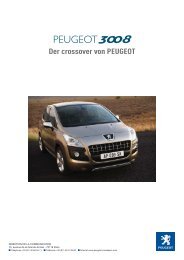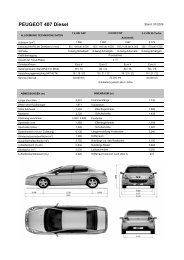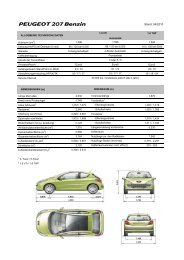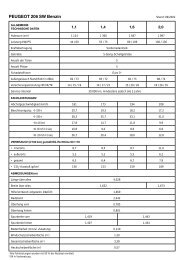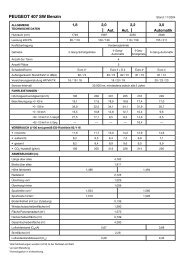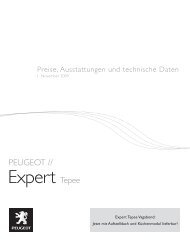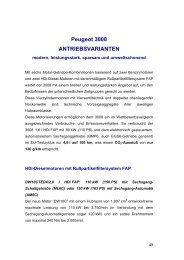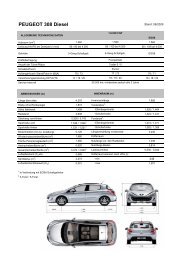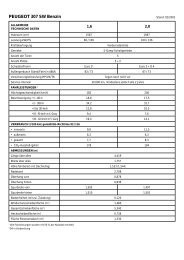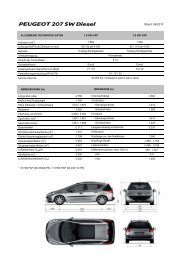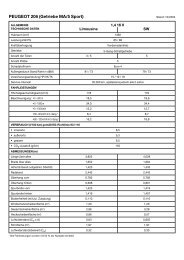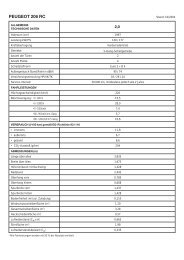PSA COUV page . page RA GB - PEUGEOT Presse
PSA COUV page . page RA GB - PEUGEOT Presse
PSA COUV page . page RA GB - PEUGEOT Presse
Create successful ePaper yourself
Turn your PDF publications into a flip-book with our unique Google optimized e-Paper software.
Corporate Citizenship<br />
<strong>PSA</strong> <strong>PEUGEOT</strong> CITROEN EXCELS<br />
IN ACTIVE SAFETY<br />
To ensure that the Group’s cars meet its<br />
ambitious safety objectives, close attention<br />
is paid to every component that might<br />
affect active safety.<br />
• Visibility and lighting<br />
Automobile safety depends on “seeing<br />
well and being seen.” <strong>PSA</strong> Peugeot Citroën<br />
has been a trailblazer in this area since<br />
1989, when it introduced innovative<br />
complex surface headlights on the Citroën<br />
XM. Today, discharge lamps that generate<br />
more intense light beams are used on<br />
models such as the Peugeot 607 and 807<br />
and the Citroën C5 and C8.<br />
In 1995, the Group was also the first<br />
carmaker to install auto rain-sensing systems<br />
as standard equipment on several of its<br />
models. The sensors automatically adjust<br />
wiper speed so that drivers don’t have to<br />
take their hands off the steering wheel.<br />
To warn other drivers automatically of<br />
potential danger, the Peugeot 206, 307<br />
and 807 and the Citroën C3, C5 and C8<br />
are factory-equipped with a system that<br />
automatically causes hazard flashers to<br />
blink during sharp braking.<br />
• Ergonomics<br />
Postural ergonomics help to minimize<br />
driver fatigue. An example is positioning<br />
the gearshift knob near the steering wheel<br />
of the Citroën Picasso, Citroën C8 and<br />
Peugeot 807, which also makes the<br />
passenger compartment more modular<br />
and easier to move around in. Cognitive<br />
ergonomics focus on making a car’s<br />
“human-machine interfaces”—like control<br />
stalks, multi-purpose screens, and<br />
dashboard buttons—immediately<br />
understandable to minimize driver<br />
distraction.<br />
• Braking systems<br />
<strong>PSA</strong> Peugeot Citroën rapidly introduced<br />
ABS systems as standard equipment on<br />
almost all lines. Ideally, training courses<br />
should teach drivers to use the full<br />
potential of the ABS system and in<br />
particular to learn how it can help them<br />
maintain control in emergency situations.<br />
Another improvement is the electronic<br />
brake control valve and brake-assist<br />
system, which adjusts rear-brake pressure,<br />
thereby preventing wheel lock and any<br />
resulting loss of steering control. This<br />
system is currently offered as standard<br />
equipment on the Citroën C3 and C5 and<br />
the Peugeot 307.<br />
• Driver assistance systems (ESP, ASR)<br />
The electronic stability program (ESP) and<br />
acceleration skid control (ASR) are two<br />
innovations currently offered on high-end<br />
models. While ESP and ASR-equipped<br />
vehicles are still subject to physical laws,<br />
these systems do help to rectify minor<br />
driving errors and decrease the probability<br />
of losing control of the vehicle.<br />
• Tire pressure sensors<br />
Low tire pressure increases the risk of a<br />
loss of trajectory stability. Pressure sensors<br />
installed on tire valves alert the driver<br />
when pressure falls too low. The system<br />
is already available on the Peugeot 607<br />
and Citroën C5 and will gradually be<br />
extended to other models.<br />
• Programmable speed alert systems<br />
<strong>PSA</strong> Peugeot Citroën has developed<br />
programmable speed alert systems that<br />
enable drivers to choose a maximum<br />
speed (for example, 50 kilometers an hour<br />
in town). An audio signal sounds each<br />
time the vehicle exceeds the chosen speed.<br />
The system is standard equipment on the<br />
Citroën C3, C5 and C8 and the Xsara,<br />
the Xsara Picasso, and the Peugeot 807,<br />
launched in 2002.<br />
THE <strong>PSA</strong> <strong>PEUGEOT</strong> CITROËN/<br />
RENAULT LAB: SCIENTIFIC<br />
EXPERTISE SERVING THE<br />
PUBLIC GOOD<br />
For more than 30 years, the<br />
Laboratory of Accidentology and<br />
Biomechanics (LAB), a joint undertaking<br />
of <strong>PSA</strong> Peugeot Citroën and Renault,<br />
has been acquiring invaluable<br />
knowledge in these two disciplines,<br />
whose complexity, costs and findings<br />
deserve to be shared in a “noncompetitive”<br />
environment. In 2002,<br />
LAB was a key participant in the<br />
European Accident Causation Survey<br />
(EACS) and international Cooperative<br />
Crash Injury Study (CCIS) consortium.<br />
82<br />
<strong>PSA</strong> <strong>PEUGEOT</strong> CITROËN - MANAGING BOARD REPORT



